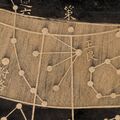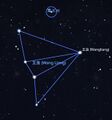Cexing: Difference between revisions
No edit summary |
No edit summary |
||
| (One intermediate revision by the same user not shown) | |||
| Line 1: | Line 1: | ||
[[Ce|Cè]] (Whip, 策) or Cexing (whip star) is a traditional Chinese star name representing the horsewhip, located beside the asterism [[Wangliang|Wangliang (王良)]] and closely associated with both [[Wangliang]] and [[Tiansi|Tiansi (天駟)]]. It belongs to the Gān school. |
Cexing is a modern IAU-star name for κ Cas. [[Ce|Cè]] (Whip, 策) or Cexing (whip star) is a traditional Chinese star name representing the horsewhip, located beside the asterism [[Wangliang|Wangliang (王良)]] and closely associated with both [[Wangliang]] and [[Tiansi|Tiansi (天駟)]]. It belongs to the Gān school. |
||
The name "Cexing" that was adopted to the IAU-CSN was already used in ancient times. A name variant is Tiance (celestial whip). |
The name "Cexing" that was adopted to the IAU-CSN was already used in ancient times. A name variant is Tiance (celestial whip). |
||
| Line 8: | Line 8: | ||
File:Qin bronze chariot.jpg|thumb|Bronze chariot in Qin dynasty (220 BCE -206 BCE). This chariot was unearthed in 1980 to the west of the burial mound of the Mausoleum of the First Qin Emperor in Lintong, Shaanxi Province. After its excavation, it was housed in the Museum of the Terracotta Warriors and Horses of the First Qin Emperor. In May 2021, the second bronze chariot was relocated to the Bronze Chariot and Horse Museum of the Mausoleum of the First Qin Emperor. |
File:Qin bronze chariot.jpg|thumb|Bronze chariot in Qin dynasty (220 BCE -206 BCE). This chariot was unearthed in 1980 to the west of the burial mound of the Mausoleum of the First Qin Emperor in Lintong, Shaanxi Province. After its excavation, it was housed in the Museum of the Terracotta Warriors and Horses of the First Qin Emperor. In May 2021, the second bronze chariot was relocated to the Bronze Chariot and Horse Museum of the Mausoleum of the First Qin Emperor. |
||
File:(Left) The end of jade horsewhip in late Shang and early Zhou dynasty and (Right) the demonstration of the horsewhip.jpg|thumb|(Left) The end of jade horsewhip in late Shang and early Zhou dynasty and (Right) the demonstration of the horsewhip. (credit: Palace Museum in Taiwan) |
File:(Left) The end of jade horsewhip in late Shang and early Zhou dynasty and (Right) the demonstration of the horsewhip.jpg|thumb|(Left) The end of jade horsewhip in late Shang and early Zhou dynasty and (Right) the demonstration of the horsewhip. (credit: Palace Museum in Taiwan) |
||
File:Wangliang and Ce in Cheonsang Yeolcha Bunyajido.jpg|thumb|Wangliang and Ce in ''Cheonsang Yeolcha Bunyajido'' |
|||
File:Wangliang and Ce before 17th Century in Stellarium.jpg|thumb|Wangliang and Ce before 17th Century in Stellarium |
|||
</gallery> |
</gallery> |
||
Latest revision as of 11:48, 13 November 2025
Cexing is a modern IAU-star name for κ Cas. Cè (Whip, 策) or Cexing (whip star) is a traditional Chinese star name representing the horsewhip, located beside the asterism Wangliang (王良) and closely associated with both Wangliang (王良) and Tiansi (天駟). It belongs to the Gān school.
The name "Cexing" that was adopted to the IAU-CSN was already used in ancient times. A name variant is Tiance (celestial whip).
Concordance, Etymology, History
The main asterism here is Wangliang, a legendary general sitting in a chariot driven by four horses (quadriga).
Bronze chariot in Qin dynasty (220 BCE -206 BCE). This chariot was unearthed in 1980 to the west of the burial mound of the Mausoleum of the First Qin Emperor in Lintong, Shaanxi Province. After its excavation, it was housed in the Museum of the Terracotta Warriors and Horses of the First Qin Emperor. In May 2021, the second bronze chariot was relocated to the Bronze Chariot and Horse Museum of the Mausoleum of the First Qin Emperor.
IAU Working Group on Star Names
The name was discussed and approved by the IAU WGSN in November 2025. It was adopted to the IAU-CSN.
Weblinks
Reference
- References (general)
- References (early modern)
- Ian Ridpath's website (Star Tales )








